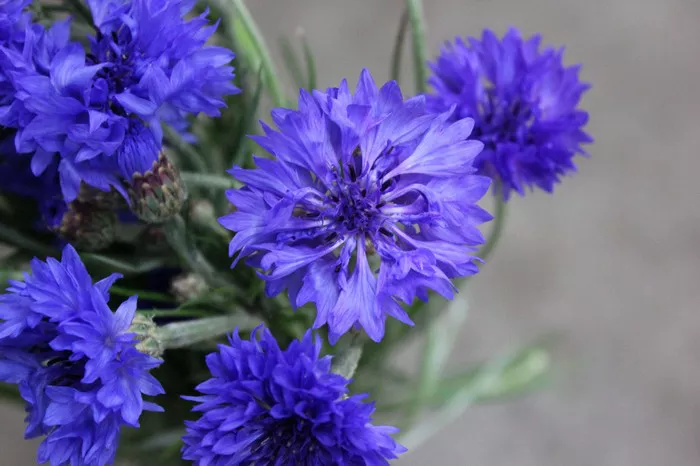Cornflowers, scientifically known as Centaurea cyanus, are charming and delicate flowers native to Europe. These vibrant blooms, often in shades of blue but also available in hues of pink, white, and purple, have long been cherished for their ornamental beauty and various uses in culinary, herbal, and decorative applications. Whether adorning gardens, bouquets, or herbal teas, cornflowers bring a touch of elegance and versatility. However, to fully harness their potential, it’s crucial to understand the art of drying them effectively.
Factors Affecting the Drying Effect of Cornflowers
Before delving into drying methods, it’s essential to grasp the factors influencing the drying process of cornflowers. Several variables can impact the outcome, including:
1. Humidity Levels: Cornflowers, like many botanical specimens, are sensitive to moisture. High humidity can prolong the drying process and increase the risk of mold and decay. Conversely, excessively dry conditions may cause the flowers to wither prematurely or lose color and vibrancy.
2. Air Circulation: Sufficient airflow is critical for effective drying. Poor ventilation can lead to uneven drying, resulting in mold or mildew formation. Proper air circulation helps maintain optimal drying conditions and preserves the integrity of the flowers.
3. Temperature: The ideal temperature for drying cornflowers typically ranges between 65°F to 95°F (18°C to 35°C). Extreme heat can cause the flowers to become brittle and lose their color, while cooler temperatures may prolong the drying time. It’s essential to strike a balance to achieve optimal results.
4. Harvesting Time: The stage at which cornflowers are harvested can significantly impact their drying quality. Flowers should be picked at their peak freshness, with petals fully open and colors vibrant. Overripe or damaged blooms may not dry well and could detract from the final product.
5. Preparation Method: Preparing cornflowers for drying involves removing excess moisture and ensuring uniformity in size and shape. Proper preparation facilitates faster drying and enhances the overall aesthetic appeal of the finished product.
Methods of Drying Cornflowers
Several methods can be employed to dry cornflowers, each offering unique benefits and considerations. Here are some popular techniques:
1. Air Drying:
This traditional method involves hanging cornflowers upside down in a well-ventilated area away from direct sunlight.
Gather small bunches of flowers and tie them together with string or twine.
Hang the bundles upside down from a hook or rack, ensuring sufficient space between each bundle to promote airflow.
Allow the flowers to dry naturally for several weeks until they feel crisp to the touch.
Once dried, gently remove the flowers from the stems and store them in a cool, dry place away from moisture and sunlight.
2. Silica Gel Drying:
Silica gel is a desiccant commonly used for drying flowers quickly while preserving their shape and color.
Fill a container with a layer of silica gel crystals.
Trim the stems of the cornflowers to the desired length and place them upright in the container.
Carefully pour more silica gel around the flowers, ensuring they are fully covered.
Seal the container with a lid and leave it undisturbed for several days to a week, depending on the thickness of the flower petals.
Once dry, gently brush off any excess silica gel from the flowers.
3. Microwave Drying:
Microwave drying is a rapid method that requires caution to prevent overheating and damage to the flowers.
Place a layer of cornflowers between two paper towels and arrange them in a single layer on a microwave-safe plate.
Microwave the flowers in short intervals of 30 seconds to 1 minute, checking regularly for dryness.
Stop microwaving once the flowers feel dry to the touch.
Allow the flowers to cool before handling them, as they may be hot immediately after microwaving.
4. Pressing:
Pressing is an age-old method of drying flowers that preserves their flat shape, making them ideal for decorative purposes.
Place cornflowers between the pages of a heavy book or flower press, ensuring they are spaced apart to prevent overlapping.
Apply gentle pressure by stacking additional books or placing weights on top of the press.
Leave the flowers undisturbed for several weeks until they are thoroughly dried and flattened.
Once dried, carefully remove the flowers from the press, taking care not to damage them.
Tips for Drying Cornflowers
Achieving optimal results when drying cornflowers requires attention to detail and proper execution. Here are some tips to enhance the drying process:
1. Choose High-Quality Flowers: Select cornflowers that are fresh, undamaged, and free from pests or disease. High-quality blooms yield superior results when dried.
2. Remove Excess Foliage: Trim excess leaves and stems from the flowers before drying to streamline the process and prevent mold growth.
3. Monitor Drying Conditions: Regularly check the drying environment for changes in humidity, temperature, and airflow. Adjust as needed to maintain optimal conditions.
4. Handle Flowers with Care: Cornflowers are delicate, so handle them gently to avoid crushing or damaging the petals during the drying process.
5. Experiment with Techniques: Explore different drying methods to find the one that best suits your preferences and objectives. Mix and match techniques for varied textures and effects.
6. Protect from Light and Moisture: Store dried cornflowers in airtight containers or sealed bags away from direct sunlight and moisture to prolong their shelf life and preserve their quality.
Conclusion
In conclusion, drying cornflowers is a rewarding endeavor that allows you to enjoy their beauty long after they have been harvested. By understanding the factors influencing the drying process, exploring various drying methods, and implementing best practices, you can successfully preserve these charming blooms for a wide range of applications, from floral arrangements to herbal crafts. With patience and attention to detail, you can unlock the full potential of cornflowers and create stunning dried specimens that captivate the senses.


